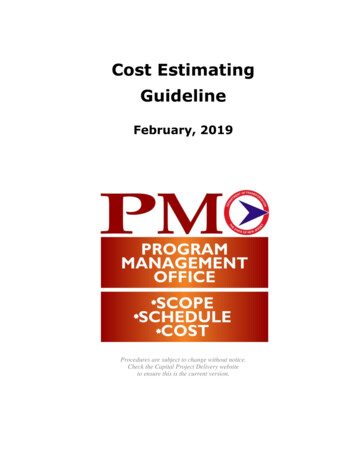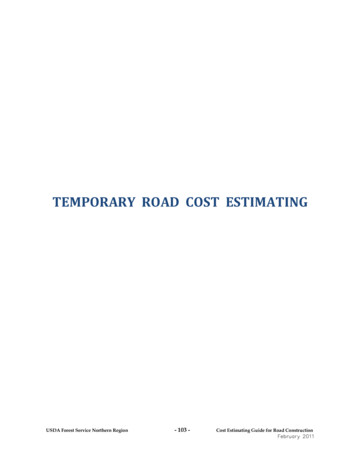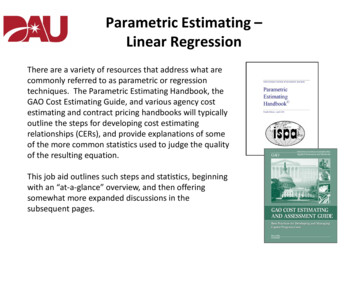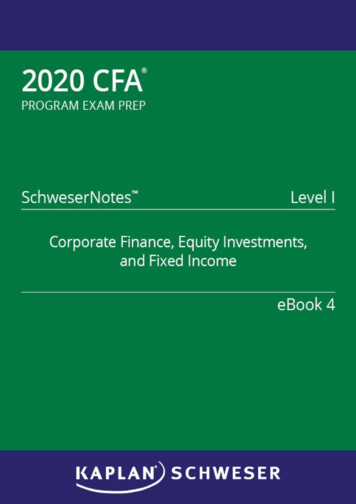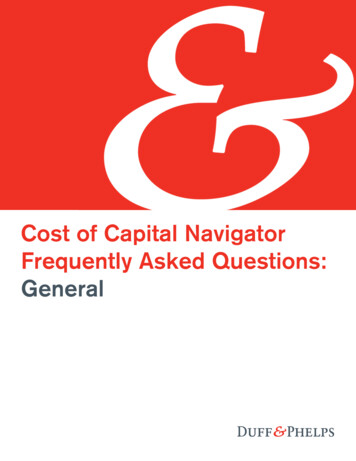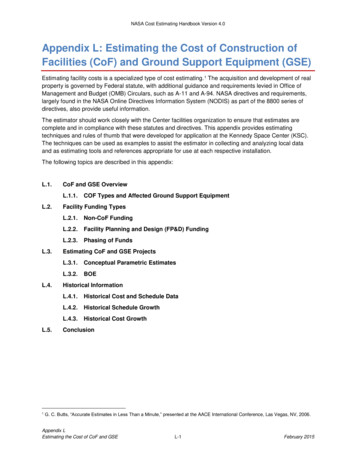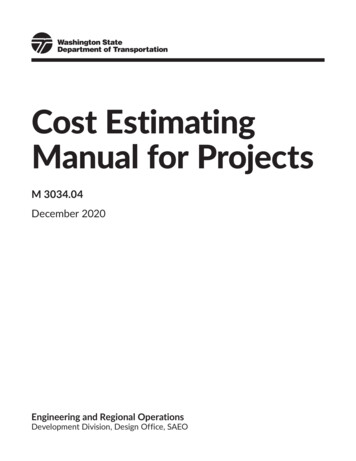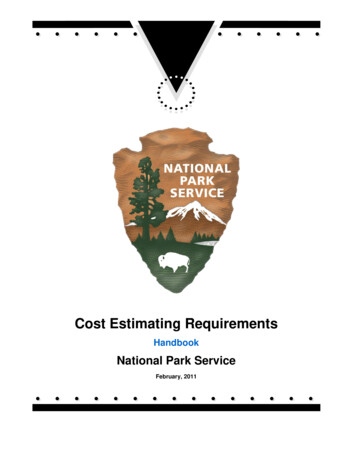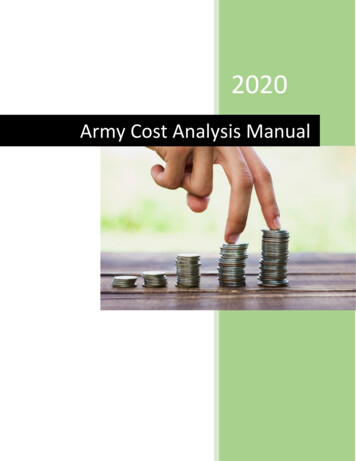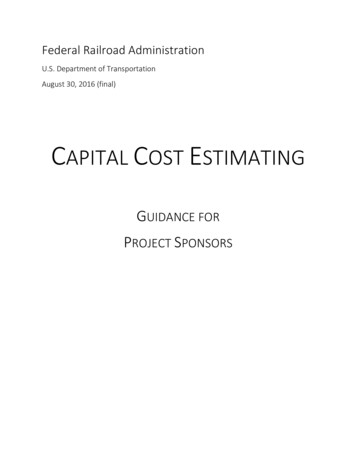
Transcription
Federal Railroad AdministrationU.S. Department of TransportationAugust 30, 2016 (final)CAPITAL COST ESTIMATINGGUIDANCE FORPROJECT SPONSORS
Table of Contents3Introduction4Cost Estimating Overview5Basic Estimating Activities6Preparing the Estimator’s Methodology Memo9Developing the Estimate20271Introduction2Using FRA Standard Cost Categories in Estimating3Methodologies4Expectations for Estimating by Phase or Milestone5Estimates with and by Host RailroadsPerforming Estimate Checks1Introduction2Risk Review as an Estimate Check3General Questions to Ask4Railroad-Specific Questions to AskSupporting Information1Project Technical Baseline2Estimating Assumptions and Ground Rules3Professional Services Costs4Ranges of Contractors’ Overhead and Indirect Costs5Work Breakdown Schedules6Contingencies7Unit Costs8Ranges of Contractors’ Overhead and Indirect Costs9Examples of Allowances and Provisional Sums2 of 33
IntroductionFRA developed this guidance document on capital cost estimating for project sponsors and the industryas part of its continuing efforts to provide technical assistance and ensure successful project delivery.FRA’s guidance emphasizes accuracy, comprehensiveness, and completeness of estimating materials, aswell as credibility. These are all qualities highlighted by the U.S. Government Accountability Office(GAO) in its own capital cost estimating guidance,1 which describes the same primary capital costestimating methodologies and activities as stated in this document.FRA’s guidance focuses specifically on railroad projects; it provides examples of common estimatingshortfalls in railroad projects; and it defines agency-specific requirements for project sponsors regardingformat and submission of cost estimate-related materials.FRA recognizes that it is not always easy to persuade stakeholders and funders of a project’s merit, or towithstand criticism for capital costs that seem “too high” and schedules that seem “too long.”2 Thepressures associated with project development and implementation can be immense. GAO recognizedthese pressures when it stated, “many organizations are not mature enough to acknowledge . . . costrisk realism because of the possible repercussions [and] . . . fear that the program could be canceled.”3With this in mind, FRA’s guidance asserts that true or “non-depressed” costs can get funded, andreminds us that delivering projects “as promised” increases industry credibility.By following FRA’s guidance, project sponsors should be better able to compensate for uncertainties,unforeseen conditions, and unknowns in capital cost estimates. Such should improve estimate reliability,and enable as-built costs to land within a reasonable range of the estimates generated at every projectphase. With a consistent estimating approach, project sponsors should be better able to make usefulcomparisons among estimates, and to evaluate their own estimates.This guidance will be incorporated by reference into FRA’s Notices of Funding Availability/Opportunityand grant and loan agreements. FRA expects project sponsors to adhere to this guidance, and theprinciples and methods described herein.FRA thanks project sponsors for their efforts to improve the reliability of their capital cost estimates andreminds them that their track records on capital cost estimating are seriously considered in FRA’sdecisions on funding and project advancement.1U.S. Government Accountability Office, “GAO Cost Estimating and Assessment Guide -- Best Practices for Developing andManaging Capital Program Costs, GAO-09-3SP,” Mar. 2009.2Note that in this document, “project” is used to mean programs of projects, planning studies, and individual projects.3U.S. Government Accountability Office, “GAO Cost Estimating and Assessment Guide -- Best Practices for Developing andManaging Capital Program Costs, GAO-09-3SP,” Mar. 2009. Chapter 9, page 81.3 of 33
Cost Estimating OverviewGAO defines a cost estimate as “the summation of individual cost elements, using established methodsand valid data, to estimate the future costs of a program, based on what is known today.” So one couldsay that cost estimating includes these steps: Subdivide the design into basic elements, such as alignment segments or type of component.Develop costs, based on similar recent projects or other valid information. Adjust for project age,duration, complexity, and geography.Total by category. Apply costs for professional services, sponsor management, and contingency.However, that would be radically simplifying the process. At the very least, three additionalconsiderations need to be taken into account.1CONSIDER COSTS STEMMING FROM OUTSIDE OF THE PHYSICAL DESIGNThe estimate needs to reflect the political and project management contexts, including conditionsassociated with the host railroad, funding entities, and stakeholder organizations. Also, it needs toreflect the selected delivery method and market conditions.2CONSIDER THE COST-IMPACTS OF TIMEThe estimate needs to reflect time. The project schedule, inflation, financing costs, and the intervalsfor release of funding have a tremendous impact on project cost.Cost estimates are built up in direct relation to project phase durations. Without a schedule, the projectmanager is unable to access the checks and balances of program management’s “three-legged stool,”that is, scope, schedule, and cost.Even if a fully detailed Critical Path Method (CPM) schedule is unavailable, the cost estimate must reflectcritical path concepts, such as activity durations, dependencies, and float or schedule contingency.Schedule contingency should be quantified to cover expected delays, such as seasonal inclementweather, and the likelihood of unexpected delays—such as time needed to repackage and rebidconstruction, or to acquire permits for differing site conditions. An overly optimistic schedule sets up aproject for cost overruns, because, like extending the schedule, accelerating construction adds labor andgeneral conditions costs.Other costs that are a function of time include inflation, finance charges, and funding intervals: If a project is stopped and restarted, the cost due to inflation alone can be significant.The entire cost of financing needs to be included in the project cost, even though payments mayextend for years after project completion.Funding intervals can constrain cash flow and, as a result, project phasing.4 of 33
3EXTRAPOLATE BEYOND WHAT IS SHOWN ON THE PROJECT DOCUMENTSTo develop a comprehensive, accurate, and credible estimate, the estimating team needs toextrapolate—create a “total picture” of the project. Typically this has to be done before all of thedesign and project management decisions are made. For example, in Planning and PreliminaryEngineering (PE), extrapolation is necessary to adequately estimate the cost of construction logistics,including access into an operating railroad.Consideration of project risks is essentially extrapolation. Through a risk review, the estimating team isable to better consider the range of potential costs associated with project uncertainties. When risks areacknowledged, and appropriate levels of compensating mitigations and contingencies are factored in,the credibility, reliability, and accuracy of the estimate are increased.Basic Estimating ActivitiesThe following cost estimating activities are required for projects receiving FRA-funds. The remainder ofthis guidance details and expands upon these activities.1PREPARING THE ESTIMATOR’S METHODOLOGY MEMOIdentify the estimating methods to be used, and document these methods in the Estimator’sMethodology Memo.This Memo (also called the Basis of Estimate) is submitted with the cost estimate to FRA for review.2DEVELOPING THE ESTIMATEEmploy proven, professional-level quantity and cost estimating methods to develop the estimate.Use a level of detail that is appropriate for the project phase and project design development. Use likefor-like historical project cost information, validate it through industry inquiries, and adjust costs forproject-specific construction and management constraints.At each phase or milestone, consider risks and uncertainties, and incorporate adequate amounts ofcontingency so the estimate will remain relatively unchanged (or will adjust to be slightly lower) as theproject moves forward from design to construction, and ultimately to revenue operations. Develop theestimate in dollars from a single base year (e.g., 2016 Base Year dollars). Then, factor in inflation overtime as indicated by the project schedule, to achieve a Year-of-Expenditure (YOE) Total Project Cost.3PERFORMING THE ESTIMATE CHECKSPerform estimate checks at each phase or milestone.Based on these checks, revise the estimate, as needed, and submit both the original and revisedestimate to FRA, along with a description of the changes made.5 of 33
Preparing the Estimator’s Methodology MemoThe Estimator’s Methodology Memo (Memo) is an essential roadmap. It is comprised of six sections.Whether the project is estimated by one team or by multiple teams, this memo helps to ensure that aconsistent, project-wide approach is taken, particularly with regard to the estimate structure and thesources and uses of pricing. This consistency can improve project coordination and completeness.Before starting, consider that a well-developed cost estimate has the following characteristics:CHARACTERISTICS OF A WELL-DEVELOPED COST ESTIMATE 41)2)3)4)5)6)7)8)Uses a consistent estimating approach,Is based on a schedule with all phases,Is well documented and traceable (and includes assumptions and ground rules),Includes contingencies (reflecting deterministic and probabilistic risk review results),Uses justifiable inflation rates,Sums to a Total Project Cost in YOE dollars,Includes management reserve if necessary,Is formally approved by the project sponsor.The Estimator’s Methodology Memo must be structured as follows:1INTRODUCTION AND PROJECT DESCRIPTIONThis section must describe the current project phase, level of project development or implementation,and other information to put the estimate in context. An example:The documents for the ABC Project are developed to 30% Design. This estimate is based on PreliminaryEngineering documents, the Final Environmental Impact Statement, Basis of Design reports and projectschedule. The project will be subject to a risk review workshop. Based on the results of the workshop, theestimate will be revised if necessary, so that it becomes a reliable starting point for Final Design.Next, develop the project description with the following parts:PROJECT DESCRIPTION1)2)3)4)5)6)7)8)4Project scope,Institutional and organizational context,Entities performing administrative/management, professional services, construction,Project schedule, major phases, year of anticipated completion,Status of project support and approvals,Status and timing of funding sources,Year of Base Year dollars, andOverall cost limits, if any.U.S. DOE, “Project Definition Rating Index Guide for . . . Construction Projects, DOE G413.3-12”6 of 33
2PROJECT TECHNICAL BASELINEThis section must describe the project documents and other materials, and address their quality andlevel of maturity. It must provide Web links to the principle reference documents, and include a list ofcost sources. It must characterize the interaction between the estimating team and project personnel,as well as the availability of documents.3ESTIMATING METHODOLOGIES AND STANDARD COST CATEGORIESThis section must describe the selected estimating methodologies used on the contemplated project.In addition, it must describe the structure of the estimate, including either a fully integrated or matrixedrelationship to the Standard Cost Categories (SCC).4SUPPORTING ASSUMPTIONS/GROUND RULESThis section, at a minimum, must describe the supporting assumptions and ground rules in this table.(See additional information on this in Using Supporting Information.)ASSUMPTIONS AND GROUND RULES1)2)3)4)5Estimate inclusions and exclusionsMethods for inflating historical unit costsMethods for calculating inflationMethods for developing contingenciesESTIMATE LIMITATIONSThis section must identify the estimate’s limitations so that the estimate is more credible,comprehensive, and supportable. It must also advise specific investigations to be performed to reduceuncertainties.5Project estimates can be weak in anticipating the costs of construction, site access, staging, andsequencing. Unfortunately, it is not uncommon for project sponsors to overlook and minimizeuncertainties, and misjudge risks in these areas. The following table, organized by risk category, providesexamples of risks, many of which also represent an optimism bias.Risk Examples by CategoryREQUIREMENTS RISK The host railroad has not yet agreed to the project.Unstable soils exist, the geotechnical investigation is incomplete, the alignment location istherefore not finalized, but Preliminary Engineering is proceeding.5Federal Railroad Administration, “Monitoring Procedure MP-40C Risk and Contingency 064.7 of 33
DESIGN RISK Normal project design development:o Is this a risk, or should design evolution and the associated cost increases be coveredthrough base costs and allocated contingency?o Do the contracts assign responsibility for cost increases due to design development?MARKET RISK A delay in obtaining resource agency permits delays start of construction.Other construction projects in the area reduce competition and labor availability.Acquiring real estate is taking longer and costing more than estimated.CONSTRUCTION RISK 6The host railroad limits work windows to only 4 hours.Inadequate capacity of domestic steel fabrication causes delay in material delivery.ESTIMATE CHECKSThis section must describe the estimate checks and include proposed dates for submissions to FRA.8 of 33
Developing the Estimate1INTRODUCTIONThe quality of a cost estimate depends heavily on the estimating team’s experience, access toinformation, assumptions, and the extent to which the team is well grounded in state-of-the-artconstruction means and methods. Through discussions with the project design and management teams,cost estimators develop an understanding of the project and its conditions, and extrapolate wheninformation is not yet developed or is limited, to produce an accurate, comprehensive, and credibleestimate.Even at the earliest planning stage, an estimate may be organized into typical and non-typical alignmentsegments and project-wide elements. Typical alignment segments will share a construction condition orrelationship to topography. For typical alignment segments, the same composite cross-section applies,as does the same aggregated unit cost. Simple stations and support facilities can also be estimated astypical elements. Complex interchanges and stations, and cuts, fills, and embankments that vary by sitecondition, are treated individually. Elements that extend along the entire project corridor, such astrackwork and signaling systems, may be estimated on either a project-wide basis or as part ofalignment segments. Throughout the estimate, a consistent use of units of measure should be employed.Sources of cost information include completed passenger rail and rail transit projects. Project sponsors,such as Amtrak, states, transportation authorities, and transit rail agencies, can provide useful as-builtconstruction cost information. Costs can also be obtained directly from host freight railroads and fromSurface Transportation Board decision documents. Commercial databases for heavy civil and buildingconstruction costs can be valuable references, and of course, the experienced estimator is likely to havehis or her own database. The Capital Cost Database, described below, is another source. Note that costsobtained from all databases should be carefully considered for accuracy and applicability.2USING FRA STANDARD COST CATEGORIES IN ESTIMATING2.1 STANDARD COST CATEGORIES FORMATThe Standard Cost Categories (SCC) are both a structure and a summary for the capital cost estimate.The SCC format must be used for FRA-funded railroad projects, to obtain important consistency in thereporting, estimating, and managing of capital costs. Often, the SCC format is the foundation orstructure for the actual estimate. Sometimes however, the actual estimate is structured differently, andthe SCC’s categories and line items are cross-walked to the other structure. Either way, the SCC formatfacilitates comparisons among estimates, and, for an individual project, the consistency of the SCCmakes it easier to track, evaluate, and control cost changes over time.The SCC worksheets are available at https://www.fra.dot.gov/eLib/details/L16055.Both the FRA Main Worksheet and FRA Inflation Worksheet include ten categories with sub-categorieswithin each. The third worksheet, FRA SCC - What to include Where, provides direction on whichcategories and line items to use for the various project elements.9 of 33
The SCC format is also a helpful project management tool. The Main Worksheet, facilitates cost estimatereasonability checks through its display of the percentage relationships among cost elements: Guideway and track, stations, support facilities, sitework, and systems: Each is calculated as apercentage of construction; andConstruction, real estate, vehicles, professional services, unallocated contingency, financecharges: Each is calculated as a percentage of Total Project Cost (TPC).For complex passenger rail projects, the following percentage ranges are fairly typical:ELEMENTSPERCENTAGE OF TPCSCC 10 – 50 ConstructionSCC 80 Professional ServicesSCC 90 Unallocated Contingency60 – 75%20 – 35%5 – 8%On the Inflation worksheet, Base Year costs are distributed across time, according to the projectschedule. Inflation rates are designated, multiplied by the base year costs, compounded, and summedto become a Year-of-Expenditure Total Project Cost. The inflated costs are automatically transferredback to the Main worksheet.2.2 BASE YEAR DOLLARS, INFLATION, YEAR-OF-EXPENDITURE DOLLARSCosts are typically estimated in Base Year dollars associated with a single year. When starting anestimate, it is important to inflate historical unit costs, allowances, and other costs, to a single BaseYear—preferably the current year. Consider an estimate in Base Year dollars as a concept—it is “as if”the project could be planned, designed and built in only 1 year.Inflation is a sustained change in the general price of goods and services in an economy over a period oftime, due to changes in global or regional supply and demand for labor and materials. Typically, generalprice levels increase over time, and reduce the buying power of money.To arrive at a Total Project Cost in Year-of-Expenditure (YOE) dollars, Base Year costs are distributedover time, according to the project schedule, and then multiplied by inflation factors for the variouselements (or categories), and for the individual years in the schedule.Note that the manner in which Base Year costs are distributed across time has as much and perhapsmore influence on the inflation calculation than does the choice of the inflation factor. To illustrate this,consider that a 1-year project slippage in the advertisement for bids may increase the construction costby 3 percent, all other things being equal.Note also that inflation can sometimes drive costs more than quantities or base pricing. Recall China’sconstruction boom in 2006-2007 that increased the demand for copper, steel, and cement. This boomcaused prices for these commodities and products to rise dramatically in the United States. Also, recall,when construction workers flocked to New Orleans after Hurricane Katrina in 2005, the cost forconstruction labor quickly rose in neighboring regions.Not all project elements experience the same rate of inflation, so a discrete inflation rate should beforecast for each element (track, signaling systems, stations, etc.) for each year of the project. Refer tothe Inflation worksheet in the MP-33 SCC Worksheets at https://www.fra.dot.gov/eLib/details/L16055.10 of 33
The Inflation Worksheet is structured to allow the application of inflation rates specific to each of the 10cost categories, in each project year.Sources of historical rates of inflation are the Bureau of Labor Statistics, ENR Building Cost Index andConstruction Cost Index, and the Association of American Railroads Cost Index. None of these sourcesprovides projections for the future.The Consumer Price Index can be a useful reference in projections, but a truly thorough approach toforecasting inflation for a rail project is to engage the same professional organization that is projectinginflation rates for a project’s revenues, and operations and maintenance costs, to project inflation ratesfor the project’s construction costs. While not inexpensive, this approach has recently been used for anumber of federally-funded passenger rail projects. These projections and market analysis wouldinclude an assessment of expected construction volumes in the region to identify overheating.2.3 CAPITAL COST DATABASEThe Capital Cost Database was established by the Federal Transit Administration (FTA) in 2009, toserve as an as-built capital cost reference, for use by grantees, consultants, and the U.S. Departmentof Transportation (DOT), in particular, FRA and FTA.The Capital Cost Database is located at /capitalinvestments/capital-cost-database. The database is structured around the Standard Cost Categoryformat, that is, it pulls information from the SCC Worksheets, so that little cost reconstruction isrequired to input projects.The database is currently comprised of costs for heavy, light, and commuter rail projects from across thecountry. As FRA-funded projects are completed, their as-built costs will be incorporated into thedatabase, making it even more useful as a reference.Project Sponsors are encouraged to open the database, and explore the information available there.Sample cost information from the Capital Cost Database, for illustration purposes only, is shown in thistable:Capital Cost Database F Guideway10.042Viaduct108,240LF Guideway 5,44110.061Cut and Cover,Soft SoilsTraction PowerSupply:SubstationsChicago CTA Blue LineDouglasMiami Dade MetroHeavy RailSan Francisco BART SFOExtensionHiawatha Corridor LRT2015 UnitCost 5,90130,242LF Guideway 17,399122,496Track Feet 29050.0311 of 33
3METHODOLOGIESThe three commonly used estimating methodologies (analogy, engineering build-up, and parametric)are described and compared in GAO’s cost estimating guide, as follows:The three commonly used methods for estimating costs are analogy, engineering build-up, andparametric. An analogy uses the cost of a similar program to estimate the new program and adjusts fordifferences. The engineering build-up method develops the cost estimate at the lowest level of the [WorkBreakdown Schedule] WBS, one piece at a time, and the sum of the pieces becomes the estimate. Theparametric method relates cost to one or more technical, performance, cost, or program parameters,using a statistical relationship. Which method to select depends on where the program is in its lifecycle.6Cost Estimating Methods Compared3.1 ANALOGY AND PARAMETRIC ESTIMATINGEstimating using the Analogy Method involves a comparison between two projects. Historical as-builtcost information from a “peer” project is used to estimate the cost of a contemplated project. With aone-to-one comparison, the project being estimated represents a new combination of all or someelements of the other.The Analogy Method can be developed quickly, at a low cost, and is easily understood. However, thismethod relies on one or a few points of comparison, and often true peer projects are difficult to find.6U.S. Government Accountability Office, “GAO Cost Estimating and Assessment Guide -- Best Practices for Developing andManaging Capital Program Costs, GAO-09-3SP,” Mar. 2009. Chapter 11, pages 107-108.12 of 33
Estimating using the Parametric Method uses information from many projects. As with the AnalogyMethod, peer projects need to be investigated so their complexities and details can be taken intoaccount in the comparisons.The Parametric Method uses parameters from past projects that apply to a project under development.Parameters are variables, conditions, characteristics, or measurable factors. Non-cost parameters aretechnical, physical, and performance-based, programmatic elements, such as length of railroad, track,number of stations, passengers per hour. Cost parameters are cost-based, such as the average per milecost for on-grade Class 4 track with a ballasted base.Parameters are used in Cost Estimating Relationship (CER) calculations. A CER uses one or moreindependent variables to estimate a given cost element, using a simple ratio or a more complexequation derived from regression analysis. Below are examples of the two types of CER, cost-to-cost,and non-cost-to-cost.Examples of Cost Estimating Relationships (CER)Confidence in the estimate depends on the validity of the relationships. Assumptions and cost sourcesmust be regularly reevaluated for fit with the new project. Parameters from peer projects and thecontemplated project are selected from the project technical baseline because they are “cost drivers,”that is, these parameters significantly affect cost. The project technical baseline must be sufficientlydeveloped to make the cost drivers evident. And the estimating team must make adjustments, typicallyscale adjustments, for differences in design, size, technology, complexity, performance, or operations,between the set of peer projects and the contemplated project.13 of 33
The largest variations between the peer projects and the contemplated project are typically found infoundation and subsurface requirements, and cost differences due to location or geography. Forexample, consider the construction cost difference between New York City at 31 percent above thenational average, and Longview, TX at 74 percent of the national average. Another important variation isthe difference between peer project inflation costs and the inflation-adjusted YOE cost of the projectunder development.Comparisons with peer projects must be logical, credible, and acceptable to a reasonable person. Forexample, it might be reasonable to compare the historical costs of a 10-mile tunnel project with aproposed 10- or 15-mile tunnel, but it would probably be unreasonable to compare it to a 1-mile tunnel,because the same construction economies of scale cannot not be obtained. The Estimator’sMethodology Memo should describe the peer projects and the scale adjustments made to theparameters.Cost estimators typically use the Analogy and Parametric Methods in Planning/Concept Design, whenkey characteristics are known, and some technical definition exists. These methods can also be used asorder-of-magnitude checks or “sanity checks” on Preliminary Engineering or Final Design estimates.CER, integral to the Parametric Method, are key building blocks in all estimating approaches. As anexample, professional services are typically estimated as a percentage of construction cost, and are alsoevaluated as a percentage of TPC.3.2 ENGINEERING BUILD-UP ESTIMATINGThe Engineering Build-up Estimating Method is based on a project configuration and design that isadvanced enough to allow accurate measurement of materials and quantities. This estimating methodapplies unit costs, not to composite cross-sections, but to discrete quantities.Unit costs are applied to material, labor, equipment, overhead, and fees. Labor unit costs can be basedon crew productivities, built up from wage rates, fringe benefits, insurances, and taxes. Material andequipment rental rates can be based on quotes or recent projects, and need to include appropriatewaste factors, and sales taxes.In the Engineering Build-up Method, estimates for work packages in a Work Breakdown Structure (WBS),are totaled to become the bulk of the project estimate.The WBS is a deliverable-oriented hierarchical decomposition of the work to be executed by thegrantee/program team, to accomplish the project objectives and create the required deliverables. TheWBS subdivides the project work into smaller, more manageable pieces of work, with each descendinglevel of the WBS representing an increasingly detailed definition of the project work. The planned workcontained within the lowest-level WBS components (work packages) can be scheduled, cost estimated,monitored, and controlled.7For more information on WBS, refer to Using Supporting Information, in this guide.In the Engineering Build-up Method, the estimating team can determine what the estimate does anddoes not include based on a comparison with the project documents. The primary cost contributors7Federal Transit Administration, “FTA Project and Construction Management Guidelines, 2016,” pages 3-10.14 of 33
should be evident. However, the detailed nature of the estimate can give a false sense of certainty andcompleteness. The estimating team must extrapolate beyond what is shown in the project documents.Because estimates typically source quantities from Building Information Modeling (BIM) models, missingscope or design information will not be estimated, unless, through its experience, the estimating teamextrapolates. In addition, the estimate must be examined for an optimism bias in the unit costs,assumptions, and ground rules—as small errors compound when summed.4EXPECTATIONS FOR ESTIMATING BY PHASE OR MILESTONEThe level of detail in the estimate changes with each phase. The appropriate level of detail is thatwhich is relevant to the decisions at hand:If a particular level of uncert
Aug 30, 2016 · 1 U.S. Government Accountability Office, “GAO Cost Estimating and Assessment Guide -- Best Practices for Developing and Managing Capital Program Costs, GAO-09-3SP,” Mar. 2009. 2 Note that in this document, “project” is used to mean program
